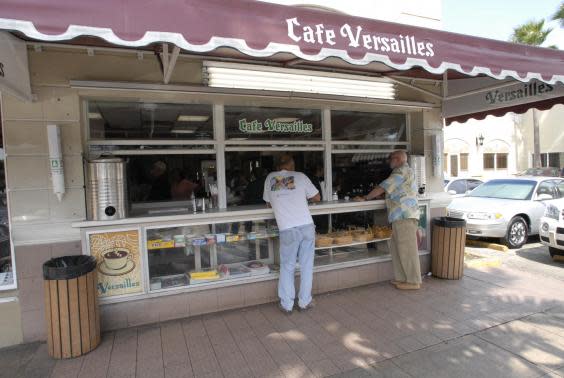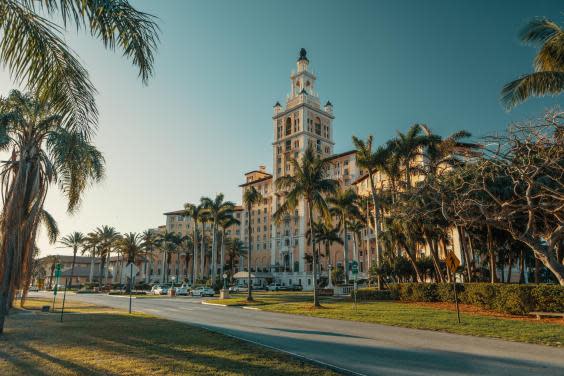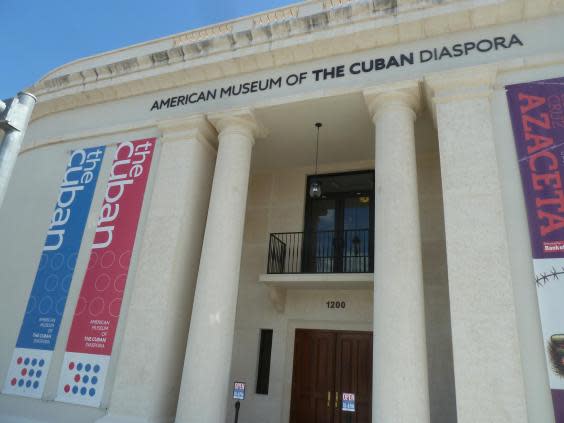How to experience Cuba in Miami
Compared with beautiful decaying Havana, 500 years old this year, the skyscrapers and freeways of Miami, the capital of the Cuban diaspora, seem ever more upstart and Dubai-like. But the common history of Cuba and Miami is a lot older, though you have to search for evidence of it through the vast grid of the Florida metropolis. And constantly evolving Latin Miami is about more than just Cubans.
A good symbolic starting point for exploration is the Freedom Tower on Miami’s Biscayne Boulevard. This 1920s Mediterranean Revival tower block, modelled on Seville’s Giralda, was originally built as offices for the Miami News but is now a museum. Dominating the mezzanine is a magnificent mural depicting the arrival on the Florida coast of the Spanish conquistador Ponce de Leon in 1513 on his way to conquests in the Caribbean, of which Cuba became the jewel. The Freedom Tower got its nickname in the 1960s when it became a reception centre for the flood of refugees from the Cuban revolution. And it’s still functioning as a beacon for refugees today: the black-and-white-tiled forecourt is the scene of demonstrations in support of Venezuelans fleeing the penury created by the late president Hugo Chavez, the Castro of Caracas.
But Cubans, who make up more than half the city’s population, are still the leaders of Miami’s rich mix; and the 10 miles of straight, flat bitumen of Calle Ocho, their funky, dishevelled version of Oxford Street, is constantly evolving. New generations take over weather-beaten old classics like the Yissell Bakery or the Palacio de Frutas, and new cafes continue to pop up, most recently La Colada Gourmet, run by an ex-lawyer from Havana and his wife, a flight attendant for Cubana airlines.
Halfway up 8th Street, the Versailles restaurant, a riot of mock 18th century masonry, 1960s Louis XIV formica, chandeliers and mirrors, is untouchable as a Cuban icon – it’s the place TV crews go for vox pops on events in Havana. Felipe Valls, son of the founder, reckons Cubans introduced fine dining to Miami though his empire, which includes the Cuban country café chain La Carreta. The latest addition will shortly be a new 125-room hotel adjoining Versailles, a smart bit of gentrification for an area whose accommodation still consists mainly of dowdy single-storey motels.

The other big Latino hotel news comes from the glitter and hedonism out on Miami’s South Beach. Last month hailed the reopening of the Cardozo Hotel, a 1940s late-Deco building on Ocean Drive, the property of another major dynasty: the Estefans. Singer Gloria and husband and producer Emilio also own a string of restaurants, notably Lario’s, just down the beachfront promenade from the Cardozo, and two years ago pushed the boundaries of upmarket Cuban catering into the smart new Miami Design District. Their gleaming white Estefan Kitchen rubs shoulders with equally gleaming white marble Dior and Valentino shops in a palm-filled mall atrium.
Lario’s on the Beach is more atmospheric and, with age, has even taken on some of the local canteen patina of the older generation Cuban outposts, like the venerable Puerto Sagua, which still caters to the last of the impecunious old Jewish pensioners who once dominated Miami Beach. Last time I was in Lario’s, a couple of patrolling policemen popped in for a shot of strong Cuban cafecito at the bar, while a recently arrived barman from Havana made me a textbook chocolate daiquiri – essentially a rejig of the great old mulata cocktail almost extinct in Cuba itself.
The Lario’s story has added a new chapter recently. The original Larios, a now octogenarian couple named Quintin and Maria Teresa from Camaguey, can be found back manning the stoves of a little family restaurant called La Fragua where they first started out before the Estafan partnership. They’re still serving their textbook ropa vieja and vaca frita.
Southeast, the smart district of Coral Gables has its own special Cuban flavour. The flagship restaurant here is Havana Harry’s, where big family groups queue throughout the weekends, while a handful of 1920s hotels still survive on Miracle Mile. Above all there’s the Biltmore, a vast, towered and turreted colossus with mock baronial lobbies and terraces overlooking manicured tropical golf links, which is strongly reminiscent of Havana’s Hotel Nacional. And though originally created by the Wasp plutocracy, the Biltmore is now thoroughly Latinised, with gaudily clad wedding parties quaffing daiquiris and dancing to salsa and reggaeton.

When it comes to Latin music, nowadays the whole of Greater Miami is your oyster, from the smart jazz and classical collaborations featuring visiting Cuban artists like Danay Suarez and Dayramir Gonzalez at the Goldman Warehouse, to semi-underground dissident rap gigs out in the suburbs featuring performers like El Sexto and Silvito el Libre. Calle Ocho is still pretty good for old school salsa in clubs like Hoy Como Ayer, and the annual Calle Ocho Festival, a ribald, three-mile jumble of food, commerce and music, is a terrific tutorial in the changing relations between Miami and Havana. A couple of years ago I saw on one stage the grizzled salsa veteran Willie Chirino, whose song about Fidel Castro, “Requiem for a Tyrant”, is still a hymn to hardline anti-Castrists; 50 yards further down the street were Kola Loka, the dynamic young reggaeton stars from Santiago de Cuba.

Cuban Miami isn’t only eating, drinking and dancing. At the southern end of Coral Gables, the two-year-old Museum of the Cuban Diaspora stages excellent exhibitions on all aspects of Cuban life, ranging from the searing politically charged canvasses of dissident painter Luis Azaceta, to the life and costumes of Celia Cruz, the equally dissident late queen of salsa.
From the roof terrace of the Diaspora Museum you can almost see another historical link with Cuba. Overlooking the sparkling waters of Biscayne Bay, Miami City Hall occupies a low, white, Art Deco building on Dinner Quay harbour, once the Pan Am Clipper seaplane base. From here, propeller-driven Sikorsky flying boats would drone off laden with wealthy pleasure seekers bound for the casinos and cabarets of Havana in the 1940s.

Although scheduled air links with Cuba recently resumed after a 50-year hiatus, it’s uncertain what the future holds for the countries’ stormy relationship; on 5 June, President Trump’s officials announced that cruises from the US to Cuba had been banned as part of new travel restrictions. The move was an attack on Cuba’s communist regime and will “keep US dollars out of the hands of Cuban military, intelligence, and security services”, according to Steven Mnuchin, the US Treasury secretary. The most popular category of trip, known as “people-to-people” – whereby any American can legally travel to Cuba, provided they engage in a full-time schedule of activities as part of an organised group trip – is also now prohibited.
But whatever the outcome, one thing’s for sure – Miami’s Cuban influence is here to stay.
Travel essentials
Getting there
American Airlines flies daily from London Heathrow to Miami from £315.
Staying there
The Marriott group has almost 40 hotels from economy to luxury throughout Miami.
The Biltmore Hotel offers doubles from £163, room only.

